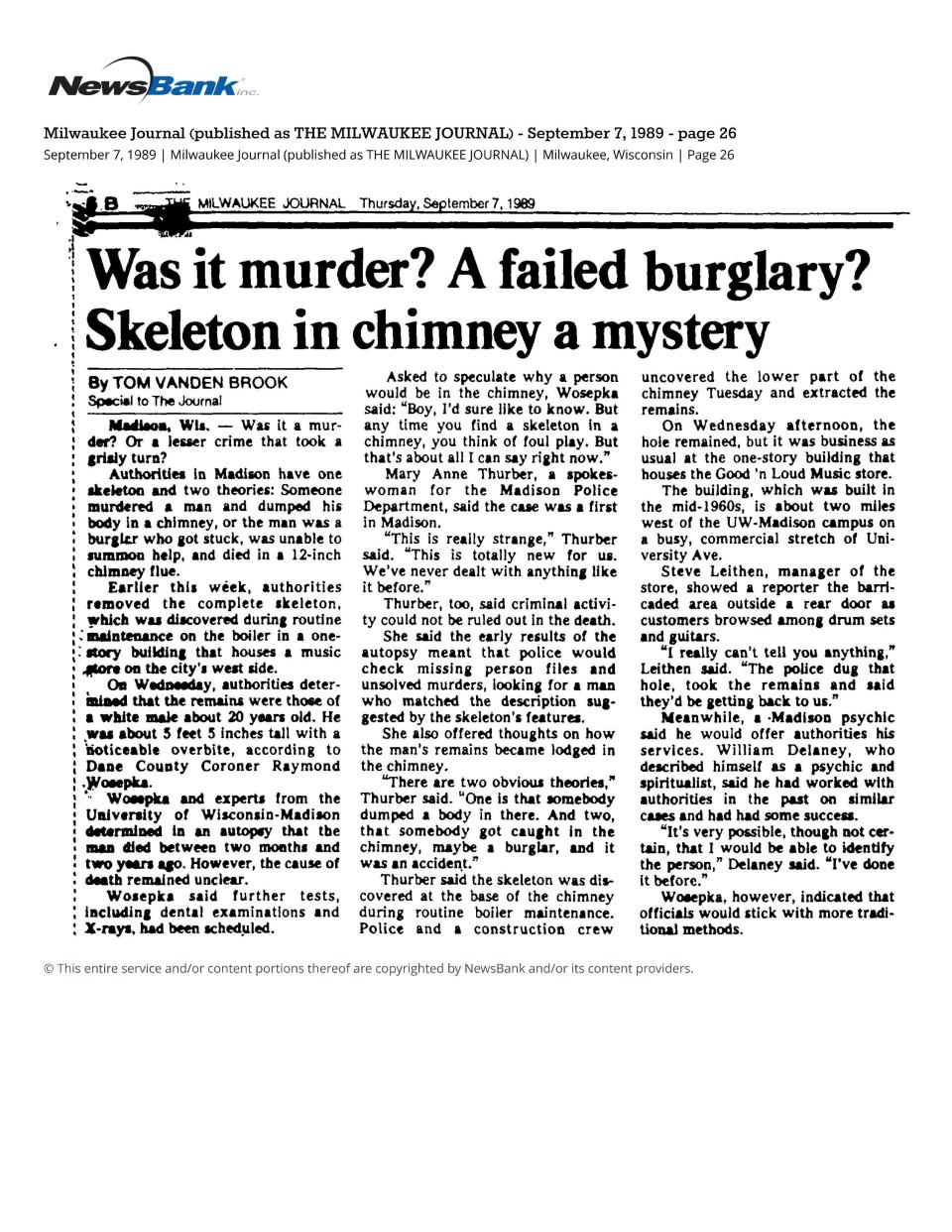After over three decades, a skeleton found in a Madison chimney has been identified
For almost 3½ decades, the mystery of a Madison skeleton that became colloquially known as “Chimney Doe” lingered. This week, it finally ended as investigators announced they identified the remains.
Found in 1989 in the now-closed Madison store Good ‘n Loud Music, representatives of a nonprofit organization identified the skeletal remain as those of Ronnie Joe Kirk, a man from Tulsa, Oklahoma. The work came two years after Madison Police Department began to work with the DNA Doe Project, a nonprofit organization that aims to help identify remains through DNA techniques.
A Sept. 7, 1989, Milwaukee Journal story said the skeleton was found earlier that week in a 12-inch chimney flue. It came during “routine boiler maintenance” and that police the next day worked with a construction crew to uncover the lower part of the building’s chimney and retrieve the skeletal remains.
That article said authorities' two theories were that he was either murdered and dumped in the chimney or he was a burglar who got stuck.

A 2012 Milwaukee Journal Sentinel article noted that, in 1990, experts at the Smithsonian Institution sculpted a reconstruction of the body's face. In 2012, a woman told police she believed the face resembled a former Capitol page and Madison police investigated the tip.
Here’s what to know about the recent breakthrough in the case:
Who was in the chimney at the former Good ‘n Loud Music in Madison?
The DNA Doe Project identified the man as Ronnie Joe Kirk from Tulsa, Oklahoma. Kirk’s skeleton was found in 1989 and was found with rotting clothing, an iron cross necklace and a butter knife.
In a summary of the case on its website, The DNA Doe Project said the clothing, which has been identified as a dress, was mislabeled as “we have found no further evidence to suggest Ronnie ever identified as anything but male.”
Who found the skeleton at the former Good ‘n Loud Music in Madison?
The Wisconsin State Journal, Madison’s newspaper, reported that Steve Liethen, the former owner of the building and music store, found it on Sept. 3, 1989.
The newspaper reported that 1970 divorce documents showed Kirk was a factory worker and had deserted his wife and child. He never appeared in court.
How was the skeleton at the former Good ‘n Loud Music in Madison identified?
According to the DNA Doe Project, the organization was contacted by Madison police in 2019. Over two years, the organization worked with the Astrea Forensics Laboratory of Santa Cruz. The lab took DNA from rootless hair to develop a DNA profile for Kirk and identify his remains.
The organization’s website said it uses new DNA techniques to analyze samples and build out family trees to help identify remains.
“In Kirk’s case, the project’s expertise shed light on his origins and paved the way for closure in a long-standing mystery,” the group’s website reads. “Ronnie Joe Kirk, who had been adopted, presented a unique challenge in tracing his familial connections.”
How did the skeleton get in the chimney at the former Good ‘n Loud Music in Madison?
It’s unclear. The DNA Doe Project and other organizations have reported that there was no way for someone to have gotten into the pipe from within the building.
The Doe Network, a nonprofit volunteer organization that aims to solve John/Jane Doe cases, said on its website that detectives it's unlikely Kirk voluntarily entered the chimney, and speculated that he may have been a burglar and became stuck before dying. Another theory is that Kirk was a murder victim and was hidden in the chimney pipe.
In the May 15 Wisconsin State Journal story, Liethen said he didn’t believe it was burglary-related.
How was Ronnie Joe Kirk killed?
That’s also unclear. However, The Doe Network said that an autopsy of the bones showed that the pelvic bones were severely fractured and appeared to have been caused when he died. It said that “some speculate the injuries were inflicted by the killer stomping” on that part of Kirk’s body.
How long was it until Ronnie Joe Kirk was found?
The State Journal reported that investigators believe Kirk’s remains were in the chimney between two months and two years.
Are there other unidentified skeletons or remains in Wisconsin?
Yes. The Wisconsin Department of Justice keeps a database of unidentified cases that lists seven, plus the previously unidentified Dane County chimney skeleton.
The National Missing and Unidentified Persons System, a federal database of unidentified, unclaimed or missing people, lists 48 unidentified persons cases in Wisconsin.
The DNA Doe Project also keeps a database of pending and past cases.
This article originally appeared on Milwaukee Journal Sentinel: Madison chimney skeleton identified in 35-year-old mystery

